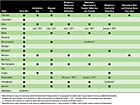Criminal behavior and running from the law are likely the furthest things from the mind of the everyday HVACR contractor or technician. It is important, however, that these individuals understand the responsibilities inherent to those who work with what is classed as hazardous materials and greenhouse gases. Unfortunately, the laws dealing with these substances are diverse and highly regionalized, making it difficult to report all the ins and outs of environmental responsibility.
Despite the complicated nature of regionalized environmental laws, three things could help keep a contractor out of jail and on the right side of the law.
- 1 - DON'T PLEAD IGNORANCE
Stupidity is never an excuse, and ignorance won’t likely cut it either. A contractor may be able to skate by on the lack of knowledge for a while, but sooner or later, the law, be it federal or regional, catches up to their illegal practices.
At the federal level, the EPA’s environmental enforcement programs are broken into multiple categories, each covering a specific sector. The National Enforcement Priorities department addresses the most widespread types of violations that also pose the greatest health and environmental risks. Federally owned facilities or businesses fall under the Federal Facility Enforcement program; and remediation and clean up fall under the Clean Up Enforcement program’s jurisdiction.

It is the intentional or deliberate violations that are classed as criminal. According to the EPA, “The Criminal Enforcement Program focuses investigative resources on cases that involve negligent, knowing, or willful violations of federal environmental law. Generally speaking, knowing violations are those that are deliberate and not the product of accident or mistake.”
That being said, mild protection from prosecution may be found in ignorance, but the next sentence from the EPA doesn’t give much room for being uneducated or playing dumb. “Knowledge of the specific statutes or regulations that prohibit the wrongful conduct is not required. When a violator is aware that the wrongful conduct is prohibited by law, the violation is said to be ‘willful.’ ”
State-level violations are often smaller and less harmful crimes that do not always warrant federal intervention. Some instances inspiring state and local intervention include: Residential or household dumping of vehicle/lawnmower oil; improper disposal of litter; use of residential garage to paint vehicles; the presence of mold in residences; and the venting of air coolants to name a few.
Understanding that environmental ignorance is not protection gives the contractor an advantage, allowing him to spend time researching and training his staff on proper handling and disposal of multiple chemicals.

- 2 - DON'T THROW EVERYTHING AWAY: RECYCLE
Disposing of refrigerant, oils, and chemicals in safe and environmentally friendly ways should help insulate contractors from any claim of illegal or criminal activity. As for proper certification, disposal of some substances requires certification to be acquired and maintained by the individual, company, or organization disposing of the material; others do not. It all depends on federal and regional mandates.
Recycling programs via local distributors are growing in popularity. The distributor, which was once just a product and part supplier, has now become a full partner and daily resource in all things HVACR; including recycling and disposal.
One such program is Thermostat Recycling Corp.’s (TRC’s) national mercury thermostat recycling initiative. TRC is a not-for-profit organization that facilitates the collection and proper disposal of mercury-containing thermostats. It has already distributed over 3,400 collection containers nationwide.
The need for this service arose as more and more states began legislating what could and could not be done with old mercury thermostats. Many states require HVAC wholesalers to collect waste mercury thermostats and for manufacturers to support (e.g., fund) a collection program(s). More states specifically prohibit the disposal of mercury thermostats. See the breakdown on Figure 1.

"HVACR contractors need an easy and affordable means to recycle waste mercury thermostats,” said Mark Tibbetts, executive director of Thermostat Recycling Corp. “By participating in TRC, HVACR wholesale distributors can meet this need at almost no cost to themselves. It’s a win for contractors, distributors, and the environment.”
TRC provides recycling containers to eligible collection locations for a one-time participation fee. The recycling containers are reusable plastic bins that hold up to 100 waste mercury-containing thermostats. Each container is clearly marked as a TRC container and also clearly indicates no products other than mercury-containing thermostats are to be placed into the container. Containers are bar-coded and assigned to each location. Each container is shipped with program guidelines, a plastic liner, twist ties for sealing the liner, zip ties for sealing the container, and a pre-paid universal waste shipping label for return shipment. Upon receipt of a container, the empty container is returned with guidelines, a new liner, zip and twist ties, and a pre-paid universal waste shipping label.
There are other recycling, reclaim, and scrap programs across the nation. Some are bringing increased foot traffic to the distributor, and many are making it simple for HVACR contractors to abide by the environmental laws and regulations required by federal and state government.
- 3 - GET HELP
Contractors should remain diligent in understanding the substances they are in contact with and the proper handling and disposal of each one according to the appropriate regulations. The differences in regional laws and regulations make it difficult to delineate an all encompassing set of guidelines for each HVACR contractor, but assistance can be found directly from the EPA, local law enforcement, and the contractor’s local distributor.
For more information, visit www.epa.gov, www.thermostat-recycle.org, or contact a local distributor. The NEWS would like to hear about the disposal, recycling, reclaim, and scrap services in which you are participating. Send your disposal/recycling stories to angelaharris@achrnews.com.
Sidebar: EPA Anniversary
The Environmental Protection Agency (EPA) is celebrating 40 years of the Clean Air Act Amendments. Signed Dec. 31, 1970, by President Richard Nixon, these landmark amendments ushered in a new era of environmental awareness and responsibility. In a 1997 report to Congress, the first 20 years of Clean Air Act programs led to the prevention of 205,000 premature deaths, 21,000 cases of heart disease, and 843,000 asthma attacks. In 1990, the act was revised and from there until 2008 emissions of six common pollutants are down 41 percent, according to the EPA. Pleased with the progress of the Clean Air Act thus far, in remarks prepared for the 40th anniversary celebration, EPA Administrator Lisa Jackson celebrated the law’s progress and looked to the future as she brought continuing challenges to the forefront of America’s environmental battle.
“Now it’s our turn to promote innovation, grow a clean economy, and address both the new challenges and the unfinished business of the Clean Air Act,” she said. “This is an ambitious effort, one that follows in the extraordinary footsteps of the last four decades. I believe that we will have our own chance to make history with the work we will set in motion.”
For more information, visit www.epa.gov.
Publication date: 01/31/2011


Report Abusive Comment